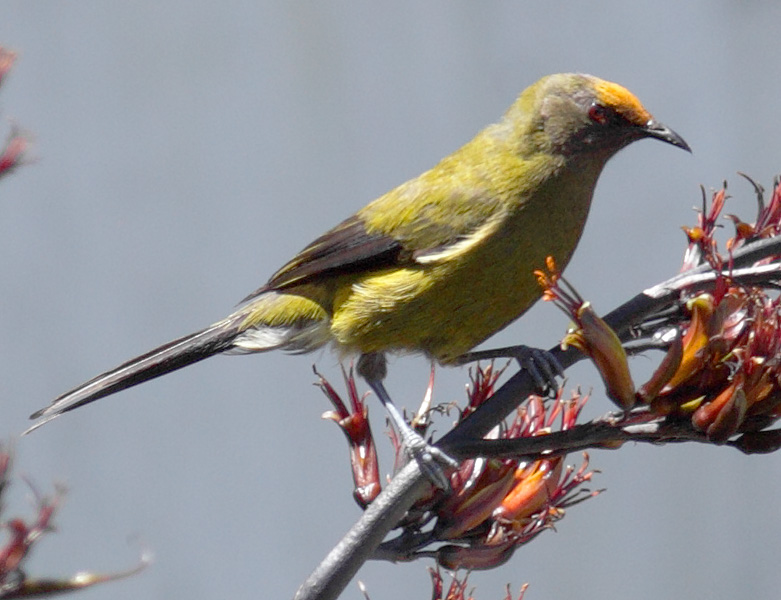
NZ Bellbird
I went back this morning to the south end of the Glenthorne Loop section of the Rockfish Valley Trail to try to re-locate the two warblers I photographed there about the same time yesterday - I wanted to record their songs and perhaps get some additional photos.
However, I did not see any warblers this morning, but perhaps heard one or two making noises close to the ground deep in some brush along Reids Creek. Several birders have responded to my request to help ID these two birds, and the responses got me asking myself some questions about identifying warblers.
To begin, I would like to consider how intermediate, advanced, and expert birders identify warblers. After taking several thousand warbler photos, including 30 of the 36 local area species, I would place myself somewhere between intermediate and advanced. I use multiple references for ID'ing warblers, but my go-to guide is the Peterson Field Guide written by Dunn and Garrett. I am the first to admit that my recognition of bird songs, especially those of many of the warblers, is not very good, and my distance eye sight is not that great either. I need to rely on close up views and the photographs I take. But I also have learned to use caution when looking at bird photos.
For example, I spent hours trying to identify a bird that I photographed last January in New Zealand. It looked like a Bellbird, but it gold crown really threw me, as there were no drawings or descriptions of any bird in my field guide that looked like what I had photographed. It wasn't until my return to the states, and e-mailing a NZ birding friend, when I learned that the gold crown was pollen from the flowers the Bellbird had been supping on.

NZ Bellbird
A couple of years ago I photographed a female Common Yellowthroat and mis-identified it. The photo was taken early in the morning, and the early sunlight had cast a yellow filter on everything. I had seen a few female Common Yellowthroats before, but none of them had looked this yellow. I also noted a split eye-ring. I looked up Common Yellowthroats in Dunn and Garrett's book. On p. 513, this reference states "virtually all [eastern races] Common Yellowthroats show some white in the belly region . . ." Well, the early morning sunlight was the first problem that affected the photo, as there was no white to be seen on this bird's belly. On the same page, the book also states that Common Yellowthroats have complete eye-rings, and the one in my photo had a split eye-ring, so I was confident, but incorrect, that this bird was not a female Common Yellowthroat.

Female Common Yellowthroat
I try to be cautious when identifying some of the warblers from my photos, but there are always a few each year that are tough to call. For example, last August I joined the Augusta Bird Club on a hike along the Rockfish Valley Trail. About 20 of us had good close-up looks for almost 10 minutes of an interesting warbler. The call in the field by the most advanced birders was a Connecticut Warbler, but after looking at my processed photos, we all agreed that it was a Nashville - that is, until a birder not with the group e-mailed me saying that he thought it was a juvenile Yellow Warbler. I then posted a query on the Virginia Bird listserver, and the overwhelming response was a Yellow Warbler. After reading ALL of the text in Dunn and Garrett's book on Yellow Warblers, I learned that juveniles can have dark legs, and not the pink legs seen on adults.
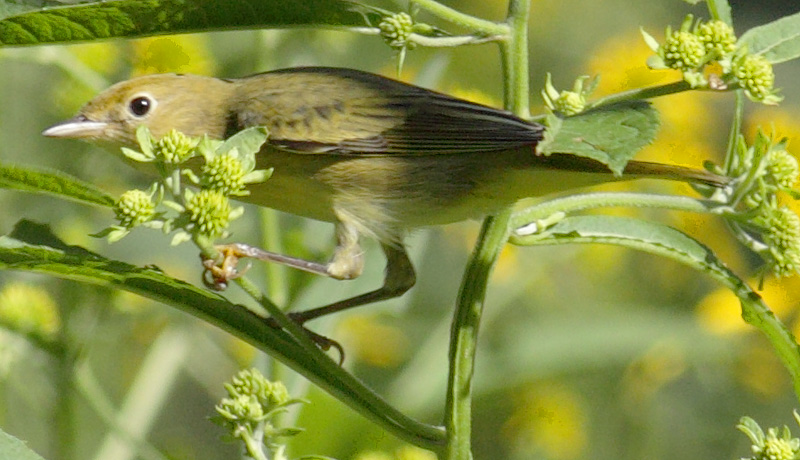
Juvenile Yellow Warbler
Now consider the two warblers I photographed yesterday on the Rockfish Valley Trail, and I repeat here what I had written in yesterday's blog:
I then decided to drive down and explore the southern end of the Glenthorne Loop trail - this has been the best place for warblers on the trail so far this year. I heard a warbler song that I could not identify, and a minute later a warbler hopped up on a branch right in front of me:
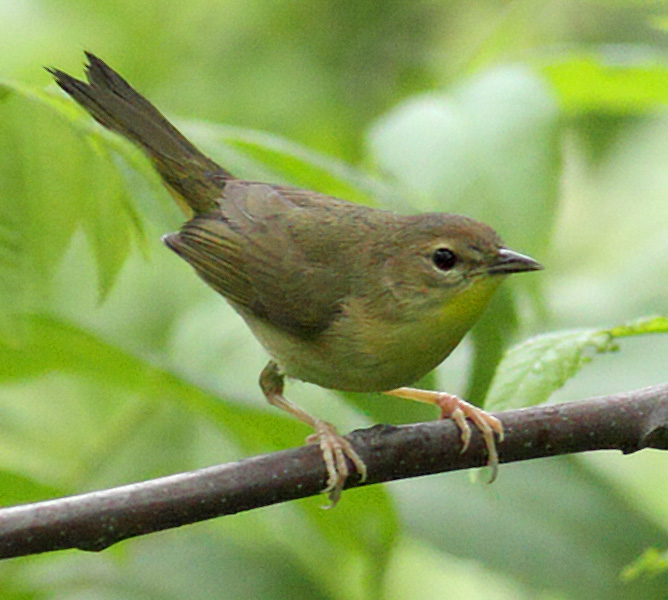
Unidentified Warbler 1
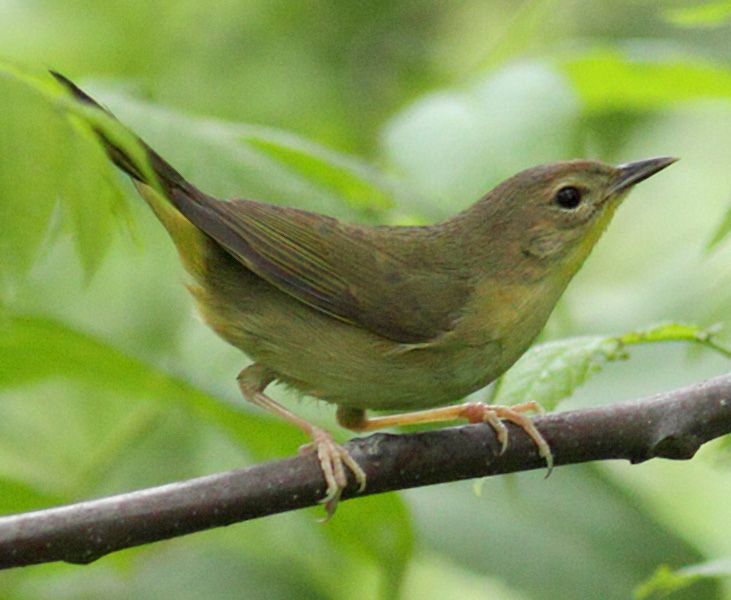
Unidentified Warbler 1
My first reaction was that it was probably a female Common Yellowthroat, but after looking at the photos, I am not sure. The split eye-ring and slightly lighter yellow rump could make it an Orange-crowned Warbler. There is a hint of orange color in this bird's crown, and the song I had heard sounded like the recording I have (Sibley's app) of an Orange-crowned. The only problem is that this bird has pink legs like a Common Yellowthroat, and not the dark legs of an Orange-crowned. I then crossed the second wooden bridge to see if I could re-locate this warbler from the other side, but saw a different warbler. This second warbler looks more like a female Common Yellowthroat with a complete eye-ring, but it has dark legs, and not pink legs. It also has some blurry breast streaking that might be found on an Orange-crowned Warbler. So I would appreciate any opinions on these two warblers.

Unidentified Warbler 2
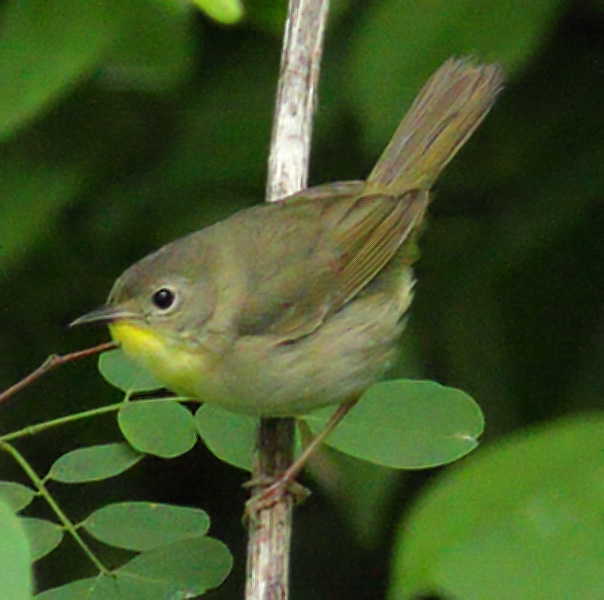
Unidentified Warbler 2
Although rare here, a couple of years ago I did photograph a warbler on the Rockfish Valley Trail that I am fairly sure was an Orange-crowned:
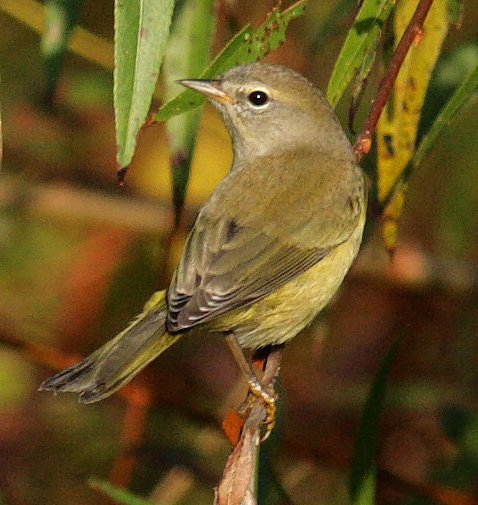
Orange-crowned Warbler
Almost all of the mid-Atlantic birders who responded to my request for help thought both birds were female Common Yellowthroats. But everyone in the mid-west who responded disagrees. Here are some of the responses:
Rob H. (MD): I am sure both warblers are female Common Yellowthroats. The bill on the first is not the pointed bill of Orange-crown. The legs on the second one have a pinkish color on my monitor.
John: There is no question but what your bird is a Common Yellowthroat . . .all the photos show traces of rust here and there in the plumage, and this is a distortion in the photos. However, that on the crown is typical. You might also note that the bill is too heavy for an Orange-crowned and the posture is typical Yellowthroat, not Orange-crowned. Photography illuminates so many features of birds that we failed to notice before our advanced technology was available, yet it also creates new muddles since we often find a photograph depicting a feature the guides don't illustrate adequately if at all and since the vagaries of light, speed, pixels, and many other factors introduce virtual features that are misleading. I don't know what to make of what you heard some bird sing whose voice you didn't recognize. Who knows whether what you saw was what you heard, but the photo is conclusive of what you saw.
Tim H. (VA): Perhaps, Common Yellowthroat . . . I think the bill is perfect for one. They tend to have heftier bills than other warblers.
Chris M. (VA): I believe both warblers are indeed Common Yellowthroats. I was just today banding a yellowthroat and I said to myself "wow he has quite a bit of orange in the head" Orange-crowns should show a faint supercillium also, the bill is wrong for Orange-crowned. Nice pics.
Kathy R. (DC): For what it's worth, I think the first one is a female Yellowthroat, and the second, an Orange-crowned Warbler.
Terry W. (TX): You got some nice shots of the unidentified warblers. I really don't have a good idea on Warbler 2, but after practically "tripping over" Orange-crowned Warblers for the past two winters, the instant I saw the photos I said to myself that's an "Orange-crowned" before I even read your story. I'd vote for Orange-crowned for unidentified warbler 1.
Dave P. (MO): The first Unk#1 is probably an Orange Crowned. The second Unk#2 is definitely a Common YT female . . . on #1, there is something about the beak that is un-warblerlike. I thought about vireo or oriole, but nothing fits.
Vic L. (VA): Birders have struggled with these challenges since "birding" began. Sometimes one must accept that a bird just can't be positively identified. And it's not even fall warbler migration time! Interesting story about the gold crown being pollen on the Bellbird.
John R.: Marshall, here are a few comments on your thread. As for the song you heard prior to this bird's popping up, are you familiar with the long, staccato trill that COYE makes? My guess is that you heard this bird deliver that trill and assumed it was a song not a call. Yes, I can see how you might think that call sounded like the recording you used of OCWA song. What's more, your four photos of the two birds impart the impression of different subspecies, the first two suggesting the nominate group (richer; yellower below, browner above), the second two suggesting a subspecies from the western group (paler; less yellow below, more grayish above). That said, there are so many recognized taxa of COYE that IDing birds on the basis of appearance alone is normally futile. Oberholser recognized 20 subspecies that had been collected in Texas; and he named half of them!
Now to the questions of your thread. The questions intermix two phenomena: 1) IDing birds in the field, and 2) IDing birds in photos. These are two different games, and the proficiency at each is informed by different skills and different training. One can be a master at one and rather poor at the other. I'll open the thread by limiting my comments to the former. Oberholser dealt with handheld birds, and that nineteenth-century form of discrimination is much more like poring over photographs than it is to contemporary field birding.
Highly experienced field birders often go by first impression, but this can always result in an incorrect ID. Yet first impressions are useful when processed properly. Of course the more experienced the field birder, the more valuable the first impression, on average. I think the so-called expert should follow the same advice I would give intermediate birders trying to develop their skills: use a first impression as a basis for questioning the conclusion drawn. And here the null hypothesis is most helpful. Why isn't the bird something to be expected rather than another species rare or out of range? Sure, we are biased by the common species that we see most of the time, but this is good, in my book. However, one must also be alert to possibilities; how one balances this is a trick to be learned on the pulses. One way of studying the birds of one's locality is to create (visual and aural) sets of species that resemble each other, regardless of range, and learn how to sort them before ID problems arise in the field. The reliability of going by first impression is won over time, often considerable time. The longer one's birding history, the more this data becomes honed. It is developed out of a myriad of data input from past experience and the experience at hand, such a vast array of data, indeed, that it can be impossible to recognize just how a given bird was IDed at a glance, much less explain how to someone else. Yet birders learning in the field should always ask those more experienced about how they made that ID so quickly. First impression IDs of photographs is another matter.
Hearing a bird sing can be definitive, but then IDing a bird vocally can present as many problems as visual IDs. Again, this depends on the experience of the birder. Complicating issues arise with variation, the distance involved, the ambient sounds and noise, the acuity of one's hearing, etc. American Redstarts have an enormous range of variation in their song. This is also true of Orchard Oriole and many other North American species. One might also ask, How many times do you have to hear the bird before making the call? I like to hear a bird that I'm puzzled over sing a second time before relying on the ID. Even then, errors cannot be entirely eliminated. If at all possible, one should make a recording of the song, even if it's made on one's smart phone. While this is not free of other issues, it can be conclusive.
There is a good deal to say about the game of IDing birds in photos, but I've already taken up too much of your blog and have imposed on the patience of your readers. I'll let others take it from here. If articulating some of the strategies for reading photos develops, perhaps I'll have something else to say.
Ben J. (VA): A few comments. First, none of the photos shows what I would call a true split eyering, just a weak eyering. This is related to the fact that the photos don’t show even a thin dark eyeline, which orange-crowned should show. I’m not sure what you mean the rump: on my monitor, the rump doesn’t even appear slightly more yellow. Second, it does appear that there is a slight hint of orange on the head. This is the sort of thing that you wouldn’t notice in the field. I certainly don’t recall noticing this. However, I note that the yellowthroat plate in Warblers of the Americas (Curson, et al.) shows exactly this. Third, No. 2’s legs are darker, but I wouldn’t call them dark; for a warbler, they are still rather light. I also would describe it as having even blurry streaks: what you see in the first photo could just be shadow corresponding to different feather tracks.
At the risk of being a killjoy, I’m not convinced by the photo labeled “Orange-crowned Warbler.” Again, the bill looks large, the legs a bit light (although perhaps darker than a typical yellowthroat). The face pattern is closer to orange-crowned than the other birds, but still doesn’t show much of a dark eyeline. The underparts are not visible. If seen in the east, I would at best put it down an interesting warbler that might be an orange-crowned.
One caveat: I have little experience with orange-crowneds. I’ve seen a few out west. But they are rare in the east, very rare in spring. This alone is a reason to be very skeptical: in the east, you should have a strong basis for ruling out other species.
Keep asking questions. We can all learn from thinking about great photos like these.
My response: I agree that both of these warblers are most likely female Common Yellowthroats, but found it interesting that mid-westerners, who see Orange-crowned Warblers more often than we do here in the mid-Atlantic area, thought the first one was an OC. This is what prompted me to start the thread discussion. There are some more photos of the bird that I have labeled as Orange-crowned on my website:
I have looked at all the photos, read everything I could find on OC, and all the features seem to be there, so I am comfortable with the call on this one.
John R.: Marshall is right about his OCWA ID.
A couple of comments about Ben's remarks. I think the bill may look large to an observer of the photo because the bird is looking back over its shoulder and the photo is foreshortening the rest of the body. However, the bill's shape is well within the range of variation for Oreothlypis, and its sharp point is correct for OCWA. In life OCWAs vary considerably in leg color; H. C. Oberholser, whose detailed study of specimens was unsurpassed by any ornithologist, describes the legs, feet, and toes (of nominate celata alone) as follows: "legs dull plumbeous or dull brown; feet olive, dark greenish slate, dull brown, or greenish yellow; soles of toes greenish yellow; claws dark brown." The virtual anatomy of Marshall's bird certainly falls within that range. (Nor is there a "typical yellowthroat" since there are anywhere from 13-20 subspecies of COYE, and the legs of G. t. marilandica vary, fide HCO, from "sepia, cinnamon, clay color, flesh color, light fawn color, or cream color.") If we make the mistake of consulting an illustration of OCWA (for example, Quinn's in Curson et al.), we see dark legs and feet with no noticeable variation in all his four examples. The face pattern of Marshall's bird is fine for OCWA; no serious distortion there. OCWA's dark eye-line not only varies among individuals but can be eliminated in a photograph due to light, exposure, etc. Finally, the mixture and placement of olive, gray, and yellow on this bird cries out OCWA and suggests no congener or other warbler. I think Ben's procedure reveals the pitfall of comparing photos with illustrations in guides, even the best we have, whose purpose is never to illustrate all possible variations. Indeed they give us a more summative interpretation of the bird's appearance, and they almost always portray that interpretation in a set pattern—a "species mug"— for comparative purposes. Photos, on the other hand, are ideal for depicting differences since no two, even of the same bird, are exactly alike. Illustrations are governed by deep time, photos by synchronic (or "real") time.
The principle here for the photobirder is to utilize the proper resources available. If the concern is range of variation, it is helpful to examine other photos. There are ample photos on the Web (including this one of Marshall's) that reveal the variation in leg color of OCWA. Photo guides indicate some variation, too, although they are self-limiting in the number of photographs that can be used. At the same time, a nineteenth-century-style description of soft parts or feather tracts is also helpful for diagnosing photos since they are so precise (normalized by Ridgway's famous color key) and executed (ideally) using freshly taken skins. That precision relates these two resources today—one contemporary, one historical—in a new way. In learning to photobird, the birder needs to analyze countless photographs and acquaint herself with the troublesome deceptions involved in virtual birding by learning the limits of any still-shot camera. Moreover, most shape and structure cannot be learned reliably from still photographs but must be learned in the field, where experience with a range of individuals in multiple situations comes to inform what amounts to a personal cognitive type. This acquired type, susceptible of adaptation and nuancing with more extensive field experience, governs how we process an interpretation of any photograph.